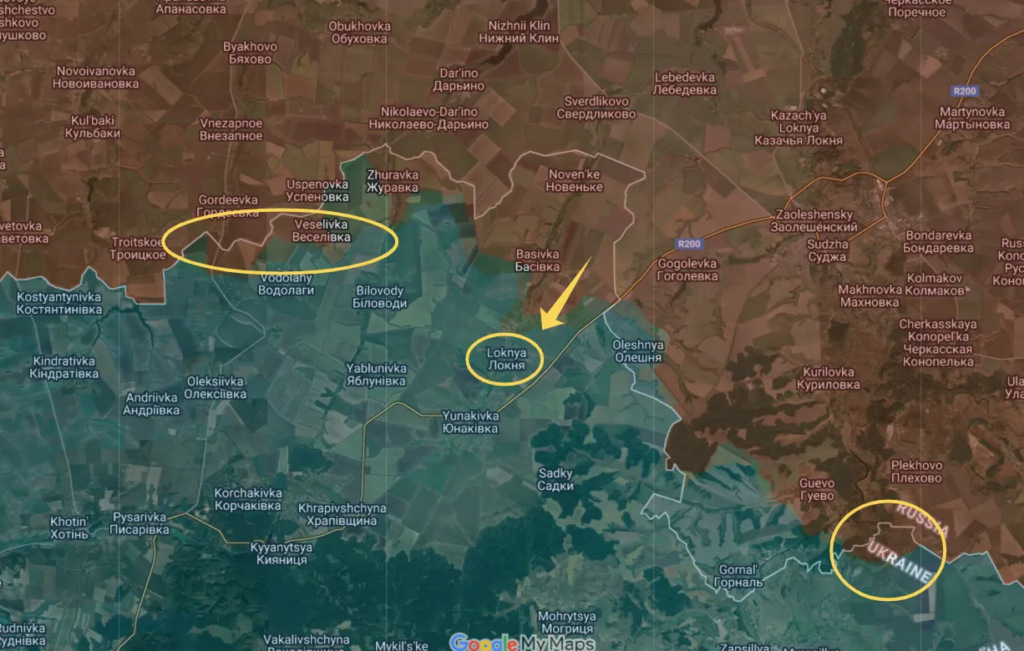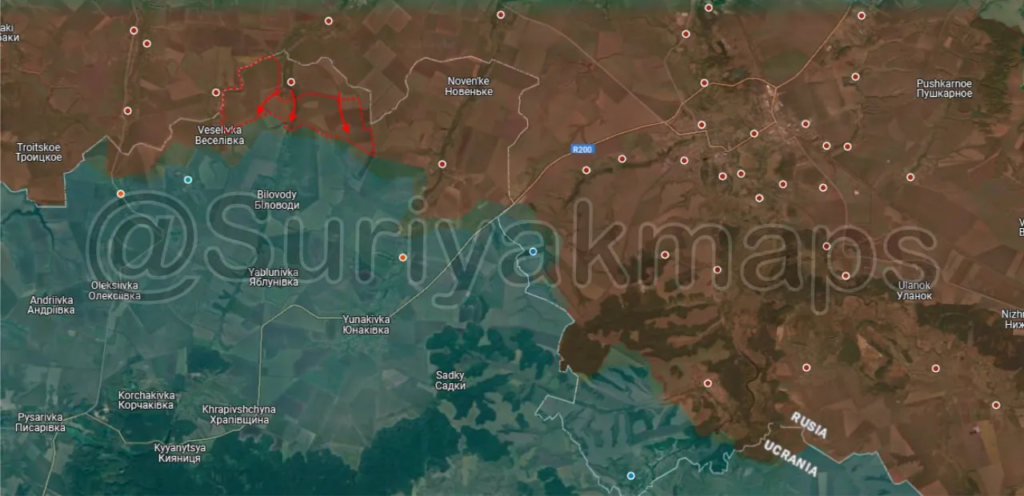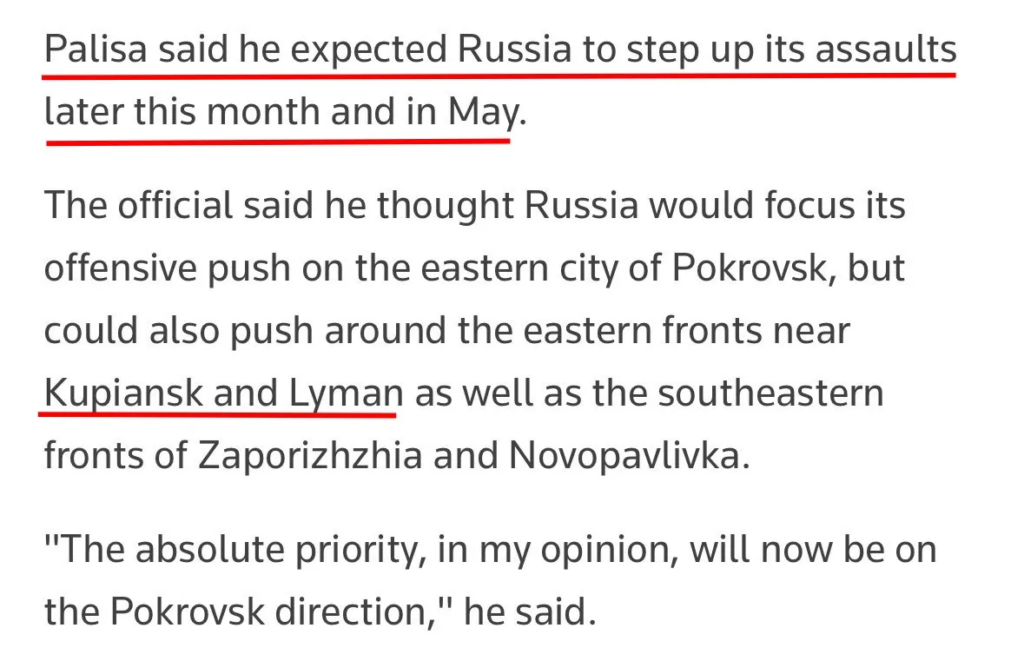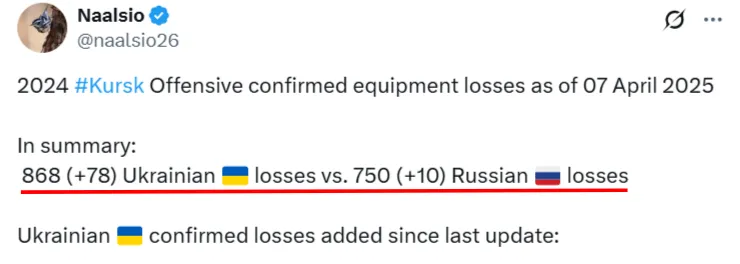As rasputitsa winds down, rumors of Russian offensives are gaining strength. In a new interview with LB.UA, Ukrainian C-in-C Syrsky has made a number of interesting statements. The first being that the Russian offensive on the Sumy and Kharkov regions has “already begun”:
"Russia's new spring offensive against northeastern Ukraine 'has actually already begun,' Commander-in-Chief Oleksandr Syrskyi said in an interview with the LB.UA outlet published on April 9. Syrskyi's comments come after President Volodymyr Zelensky warned that Moscow is amassing forces for a fresh offensive against the Kharkiv and Sumy oblasts this spring.
'I can say that the president is absolutely right, and this offensive has effectively already begun,' Syrskyi said. For nearly a week, Russian offensive operations have almost doubled in all main sectors, the commander-in-chief noted."This is borne out by frontline evidence, as Russian forces have continued to make pushes in these regions. Particularly in Sumy, Russia has advanced the past few days, capturing Veselovka and as of today entering Loknya, as seen below:


Zhurava nearby was also taken:

Russia is reportedly massively using the ‘drone ambush’ tactic in this region, where the drone sits in wait by the roadside until an AFU vehicle emerges. The below video was reportedly taken precisely near Loknya, where such Russian drones are wreaking havoc on Ukrainian logistics routes:
This is said to be the Ukrainian road-o’-death leading to Loknya, video captured from the AFU side:
In Kharkov, the front suddenly stirred awake as Russian forces made new advancements in Vovchansk for the first time in weeks if not months.
Likewise southeast of there Russian forces have been making major headway on the Lyman front. Many Ukrainian military channels have been squawking about Russian successes there in the past few days:

Another Ukrainian analyst about the above direction:
In the estuary direction, the occupiers again managed to advance deep into our positions.
This applies to the Katerynivka-Nove line, where the enemy slipped between the villages, cut both castellans connecting them, and gained a foothold.
In such conditions, the defense of Katerynivka was practically impossible, so the village is not controlled by the Defense Forces.
Then the rolls go to Novomykhaylivka and, actually, Novye. And there Lypove also goes together.
From the Makiivka district, the scum are trying to reach Hrekivka.
The occupier's intermediate goal is to capture the Andriyivka-Izyumske-Stepove line in order to paralyze logistics in both the Borivka and northern estuary directions.The places referred to are here:


In a new Reuters piece, a ‘senior Ukrainian official’ named Pavlo Palisa said that the real push is expected to begin later this month and in May:

One of the ways that we know Russia has begun stepping up offensives is the larger use of armored vehicle formations. During the winter months we saw much more small-scale action, with the now-standard ‘drip-feed’ tactic of inserting small clusters of troops into hedgerow and forest landing positions by way of light and mobile ATVs, bikes, etc.
Now we’ve again begun to see heavily armored columns of modified tanks with anti-mine rollers and the classic ‘shed’ designs. In the last Sitrep I covered the Russian 4th Motorized Rifle Brigade’s assault in the area south of Chasov Yar. Now a new look at that assault has been released, showing us an interesting aspect we rarely get to see:
In the video, we can see not only a large amount of Ukrainian FPV drones failing against the ‘fortified’ Russian tanks, but most importantly, how those tanks which are eventually disabled are brought back to life by Russian engineering forces. This casts doubt over Ukrainian daily losses claims against Russian vehicles, wherein rapidly-spliced footage shows hits on Russian tanks invariably counted as ‘kills’ when in actuality a large portion of the vehicles are towed back to repair base and diligently restored.
Also, since Russian troops are actively advancing, it makes more sense they’d have more opportunity to collect disabled but salvageable vehicles from both sides, later restoring a good percentage of them. The retreating side—that is, the AFU—gets the short end here. After all, isn’t that the excuse used by the pro-UA crowd for why Russia always collects more bodies for ‘cargo 200’ exchanges? That’s not to mention the restored vehicles are later hit again and again, vastly inflating the ‘destroyed vehicles’ category.
By the way, on that note, a member of Oryx’s team has given an update to the tally of vehicles lost in the Kursk offensive:

Note that even Oryx’s team now admit Ukraine lost more vehicles than Russia, officially painting the operation as a major failure. Now that Russia has effectively retaken virtually everything there, who do you think will be the recipient of all those destroyed vehicles, restoring a good percentage of them?
Corollary to the above—Russian forces finally fully captured the last real settlement of the Kursk region yesterday in Guevo:

Getting back to Syrsky’s interview one more time; it’s a long interview with a lot of nuggets.
Firstly, he again stokes fears of a big Russian offensive on Kiev later this year, citing the renewed large-scale ‘Zapad’ exercises in Belarus set to be held in September.
Syrsky opines:
All exercises have a purpose. In other words, the appearance of exercises is the most acceptable way to relocate, transfer troops, concentrate on a certain direction and create a group of troops.
Actually, this is how it started in 2022. You will remember that the group was initially created, it conducted exercises, and we all hoped that they would end, the Russian troops would return to their territory.
But when it was decided that these exercises were continuing, it became obvious to me that everything was going to change.The next interesting tidbit: He claims that the Russian artillery advantage is now only 2:1, rather than 10:1 like last year. He claims Ukraine’s destruction of the Russian Toropets arsenal in September 2024 caused Russia to halve its shell usage. Russia has gone from firing 40,000+ rounds per day, to 23,000 now—according to him, although it has recently “crept up a little” to 27-28k.
Interestingly enough, Le Monde just reported yesterday that Ukraine’s “largest ammunition production facility” was destroyed by Russian strikes:
Ukraine's main ammunition production facility destroyed in Shostka, Sumy region, — Le Monde
▪️The commander of the UAV company of the 104th brigade of the Ukrainian territorial defense Anton Serbin told the newspaper about this.
➖"In 2024, the Zvezda (gunpowder) and Impuls (detonators) plants were shelled several times, including on December 31, 2024, when 13 ballistic missiles were fired at them," the publication writes.
➖"Our main national ammunition production facility was destroyed," Serbin said.The most significant portion of the interview discusses mobilization numbers of both sides:
But I want to say that the front is constantly increasing, the Kursk operation and the enemy's actions in the Kharkiv region, in Volchansk, gave us an increase in the front by 200 km.
And the enemy has increased its grouping fivefold since the beginning of the aggression. Every month they increase by eight to nine thousand, for a year it turns out 120-130 thousand. On January 1, 2025, in Russia, the group of troops participating in the fighting in Ukraine numbered 603 thousand military personnel, today it is already 623 thousand.Above he states that Russia has increased the size of its entire military grouping in the SMO by fivefold since the beginning. Given that he says the Russian contingent is now at 623,000, we can assume his position as being that Russia started the conflict with a mere 125k men, not the 250k+ most often claimed.
Interestingly, Syrsky later hints another confirmation of this when he states that Russia’s assault on Kiev consisted of a mere 9 battalions—this is hardly two brigades. If the main direction was so low in manpower, how did people ever come up with the infamous “250 BTGs” hoax?
But getting back, read what he says again:
Every month they increase by eight to nine thousand, for a year it turns out 120-130 thousand. On January 1, 2025, in Russia, the group of troops participating in the fighting in Ukraine numbered 603 thousand military personnel, today it is already 623 thousand.This is critical: he’s stating that every month, Russia gains a net positive of 8-9k men, and the total grouping grows by 120-130k per year. Just from January 1, 2025, the Russian grouping has increased by 20,000. Where are Western propagandists now, who loudly proclaimed Russia is losing so much men as to be bleeding out a net monthly negative?
Hypothetically assuming the claims of both sides are true: Russia claims to recruit 30,000 men per month; Syrsky claims ~8,000-9,000 is the net gain. This implies 21-22k monthly losses, which is 700+ per day, or perhaps 300 KIA and 300 irrecoverably wounded. However, unlike Ukraine, Russia allows demobilization via contract expiry, and so a large part of those monthly losses are accounted for by soldiers leaving the SMO due to non-renewal of contract. It’s difficult to estimate the exact percentage this takes up, but let’s say it is hypothetically 50%, then it would reduce Russian KIA to 150 daily average, which is likely not far from reality. It should also be mentioned, Ukrainian officials had previously claimed Russia is lying and is only mobilizing a total of ~20k per month, which would make net losses even smaller.
Syrsky also glumly admits that Russia’s total mobilization resource is depressingly vast:
If we take the prepared mobilization resource of the enemy — those who have served in the military, military training-it is about 5 million people. And the mobilization resource as a whole is 20 million. Imagine their potential. And what can we do under these conditions? Of course, mobilization and transfer.As a last note, Syrsky interestingly admits that the entire Kursk operation was meant to slow down a planned Russian offensive across the entire front:
After that, the enemy regrouped, completed the training of the 44 corps, and in fact, from mid-June, began a strategic operation on the entire front. He began to attack vremenniy Yar, Toretsk, New York, Pokrovsk, Zaporozhye, in the Kupyansky direction, in Limansky, that is, practically everywhere.
The situation was critical, and in these conditions it was necessary to do something to weaken the enemy's onslaught as much as possible. And then, in fact, the idea was born to conduct its counteroffensive where the enemy does not expect it and where it is the weakest.So, now that Kursk is over, it seems Russia is resuming this offensive across every front, except this time Ukraine has no tricks left.
That being said, there are rumors Ukraine has been building some reserves for a new offensive attempt for the same purpose, but there’s a kind of diminishing returns effect each time for what they can muster, amidst shrinking resources.
—
To finish off the frontline updates, the other major area of offensive success has again been on the Zaporozhye line, where Russian forces completed captures along the flanks near Stepove, flattening out the front:

There are numerous other advances to be covered next time, including in Toretsk and in the south Konstantinovka direction.
In the Kupyansk direction, Ukrainian channels are even claiming Russia is using “mini submarines” to transfer troops to the growing Oskil river lodgement:
Kupyansk direction, information from "Adequate Kharkiv resident". A story is spreading in Ukrainian channels that the Russian army is using micro-submarines to transfer infantry and ammunition to the bridgehead on the western bank of Oskol. The enemy's Magyar birds are hovering over the river day and night every day, but they don't see any signs of moving forces across the river - not a single watercraft, and yet our infantry appears from somewhere on the west bank. An underground tunnel? No response yet.—
We’ve shown the photo last time, but now comes the full video from frontline reporter Kulko about the 1,600+ Ukrainian drones downed by Russian EW warfare on the Kursk front:
Likewise a frontline Zvezda report on Russian assault tactics, utilizing large smoke canisters for concealment:
Some photos of new serially produced BMP-3s and T-72B3Ms, equipped with new anti-drone rubber pads as well as factory standard EW modules:



